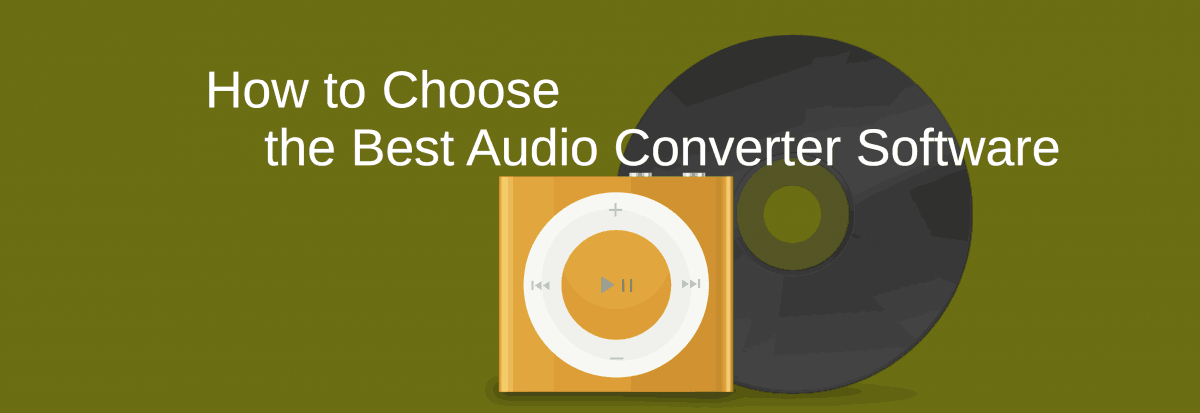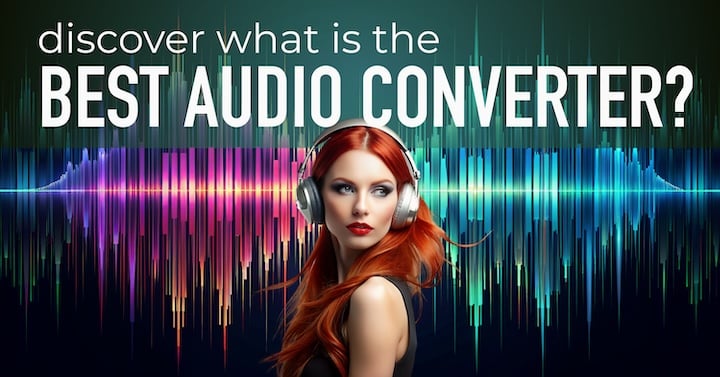
Audio Basis - articles about audio
The digital music landscape is rapidly expanding, with more high-quality tracks being bought and downloaded every day. As a result, our devices are brimming with expansive music collections.
Here's why we tweak music files:
- to match the playback capabilities of various gadgets like DACs, portable players, smartphones, car audio systems, and streaming devices.
- to shrink file sizes, making room for even more tunes on our storage drives.
- to convert multi-channel recordings into stereo format.
- and more.
Discover the top audio file converter that suits your needs. Learn how they differ and find the perfect software for converting audio files on Windows, Mac OS, and beyond. Start exploring now to enhance your listening experience.
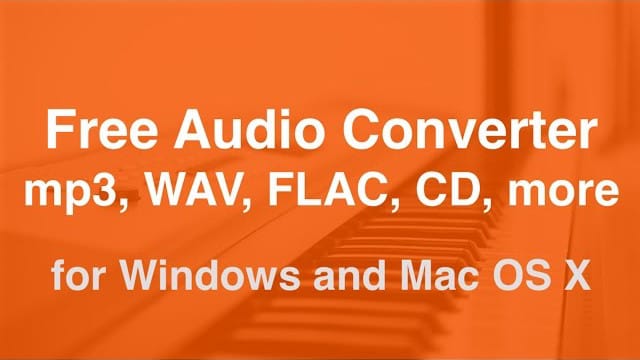

If you buy "AuI ConverteR PROduce-RD" (2023/12.x version) from 24 August 2023 to 24 October 2023, you will get free update to version 2024 (13.x) after its release.
Also read How to Improve Sound Quality >
Back to top
What is the best audio converter software?
The key to a great audio converter is keeping the original sound quality intact.
Certain music files can be changed from one type to another without any quality loss:
- CD tracks, FLAC, WAV, AIFF, ALAC can be switched to FLAC, WAV, AIFF, ALAC seamlessly.
- ISO, DSF, DFF files can be converted to DSF, DFF without sacrificing sound quality.
This flawless conversion is achievable if the original and final sample rates and bit depths match.
However, changing sample rates or bit depths, adjusting volume, and applying filters cause the losses. For the best audio converter software, these losses are extremely small.
Back to top
Home vs pro audio converters
The software has several classes of processing quality:
- home programs;
- professional audio converter software.
Home and professional audio converters
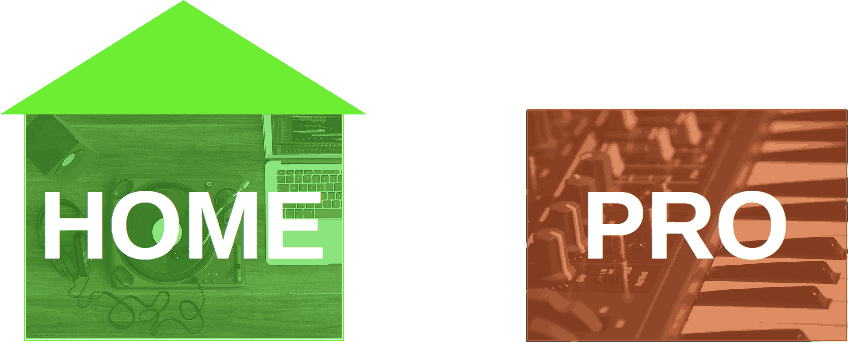
It is an approximate class definition. There are no standard definitions.
Professional conversion tools should provide a significant reserve of processing quality. It needs to conversion that is transparent for user.
Converting programs have many features (see list below). To choose the program, it needs to find the most useful one for your requirements. You can compare the different software according to personal demands. On the Internet, free audio converters are available. Commercial utilities also have free demo versions, as rule.
Back to top
Top 5 online audio converters
Online audio converters are located on websites. They work via webrowser. These conversion services are compatible with any operating system, including iOS and Android. See out top 5 online audio converters in alphabetical order.
- Cloudconvert
mp3, AAC, AC3, WAV, AIFF, CAF, FLAC, WMA, APE, others
- Convertio
mp3, AAC, AC3, WAV, AIFF, FLAC, WMA, APE, ogg, OPUS, others
- FreeConvert
mp3, WAV, AIFF, FLAC, AAC, others
- Online Audio Converter
mp3, m4a, WAV, FLAC, ogg, amr, mp2, and m4r (iPhone ringtones)
- Online Convert
mp3, AAC, m4a, WAV, AIFF, FLAC, WMA, ogg, OPUS, MID, others
Back to top
Top 5 audio converters [Mac, Windows, Linux]
These music converters are intended for laptops and desktops. . Check out our top 5 audio converters for Mac, Windows, Linux in alphabetical order.
- AuI ConverteR 48x44
DSF, DFF, SACD ISO, FLAC, WAV, ALAC, AIFF, mp3, m4a, others
True Gapless Conversion, Safe CD ripping, Normalize Audio, Downmix multichannel to stereo, and others
Graphical User Interface, CD ripper, metadata editor
Windows, Mac (Intel, Silicon)
- ffmpeg
command line utility
WAV, AIFF, CAF, FLAC, AAC, mp3, others
Windows, Mac, Linux
- Foobar2000
Graphical User Interface, CD ripper, metadata editor
WAV, AIFF, mp3, DSF, DFF, SACD ISO (DSD input only), others
Windows
- SoX - Sound eXchange
command line utility
WAV, FLAC, DSF, DFF, others
Windows, Mac, Linux
- Weiss Saracon
Graphical User Interface
WAV, AIFF, AU, BWF, SD2, CAF, PAF, MAT, RAW, DSF, DSDIFF, FLAC, and Ogg/Vorbis
Windows, Mac
See more audiophile music converters...
Note: We are affilliated with Audiophile Inventory (AuI ConverteR).
Back to top
Music conversion program abilities
- Resampling (probably with several modes)
- Bit depth conversion
- Dithering
- Metadata export (song name, performer, album, year, artwork, etc.)
- Metadata management
- Providing metadata compatibility with different music players
- Providing different character encodings (different languages) of metadata
- CD ripping
- Providing PCM formats (WAV, FLAC, AIFF, ALAC, mp3, m4a,...)
- Providing DSD formats (ISO, DSF, DFF,..)
- Providing CUE+FLAC, CUE+WAV, CUE+DSF, ...
- Providing multichannel stuff
- Musical stuff loudness normalizing
- Gain adjusting
- Seamless album conversion
- Downmix 5.1 to stereo (multichannel to stereo)
- Other processing
- Management output stuff directory structure
- Non-English symbol support
- Audio file's conversion speed
- Distortion level (lower is better)
- Precision of sound processing math: 24/32/64-bit integer or 32/64-bit float point
- Different service functionality
- Compatibility with operating system of your computer: Mac, Windows, Linux, others
- Easy-to-use graphical user interface
- Price
Resampling is altering of sampling rate to:
- adjusting of file resolution to DAC abilities, musical programs, music players;
- file-size reducing.
Digital filters, that are used to resample:
- Linear phase filter - with linear phase response.
- Minimum phase filter - with slightly non-linear phase response, but without pre-ringing.
Read more:
Dithering is a reducing method of sound distortions. It's used in audio bit-depth converters when resolution is truncated to 16 bits.
CD ripping is copying CD audio content to sound files on hard disk of computer via CD-ripper software.

CD ripping may use different levels of access to audio data on CD:
- high-level data,
- raw-data stream (low level),
- data-error stream.
Lower-level access allows detection of CD-reading errors with higher probability. Some CD rippers can attempt to recover audio data. Though there is no 100%-probability of error detection and correct recovery.
Read more about safe CD ripping >
Music loudness normalizing is used to maximize the loudness without overload.
Also, oversampling may cause overload of resampled stuff. Normalizing allows avoiding it.
Read more about loudness normalizing >
Seamless album conversion intended to continuous musical albums like operas, live concerts, musicals, etc. All tracks of these albums should be processed without pauses and artifacts between the tracks as continuous music stream.
Read more about seamless re-sampling >
Downmix 5.1 to stereo (multichannel to stereo) is multichannel stuff transformation to playback at stereo musical device/system.
Read more about downmix 5.1 to stereo >
Metadata (metatags) is information about a music file (song name, performer, album, year, artwork, etc.).
Group editing of several files is desirable.
Popular id3 standard metadata allows assignment of several types of artworks (album cover, performer/composer/etc. photo(s), other). As rule, players read only album cover artwork. Some metadata editors may allow assignment of artwork type and/or embed several artworks to a sound file.
Read more about metadata editing >
Management output stuff directory structure is an ability of music converting tool to create/copy directory structure, name for output file. As rule, file naming by metadata is used.
Precision of processing math does not matter to end user, as rule. Precision impact on noise/distortion level and anti-overload ability of signal processing. In general, the precision of math is higher, than recommended target bit depth.
Easy-to-use graphical user interface is an important thing, because transformation of musical stuff is repeatable operation. So minimum of actions is desirable.
Price is one of the most important features of any program. There are many free music converters. Some of these converting tools are command-line utilities. Some of these utilities may be managed via front-end programs with graphical user interface.
As rule, software development project should be funded for stable customer support and functionality expansion.
This funding may be provided via donations, advertising, selling of licenses or others.
Comparison of prices should be done inside a class of converting program: pro with pro, home with home.
Back to top
How to compare music converters by sound quality
Sound converter software quality may be compared by measured distortions and noise level.
Audio quality issues of conversion tools
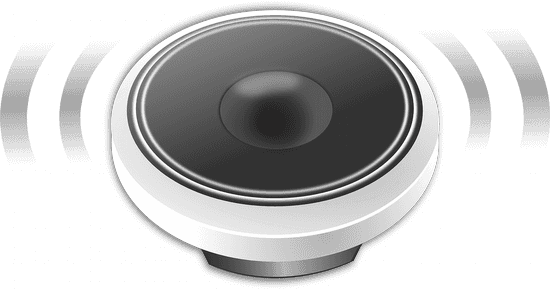
Ear listening comparison
Also you can compare converting software via ear tests:
- Take several musical samples of your favorite pieces.
- Convert it in different formats and resolutions via each item of tested conversion program.
- Compare converted files in identical resolution by different music conversion tools via your player(s).
This test don't guarantee minimal distortions for the best (in your opinion) audio converter software. But you can choose the program, that sound you like more.
Instrumental comparison via spectrum analizer
Sample rate converter software quality is tested via sweep sine. Below we can view output of resampler program.
Hi-End re-sampling of sweep sine: no aliases, only sweep sine at output - output like to input
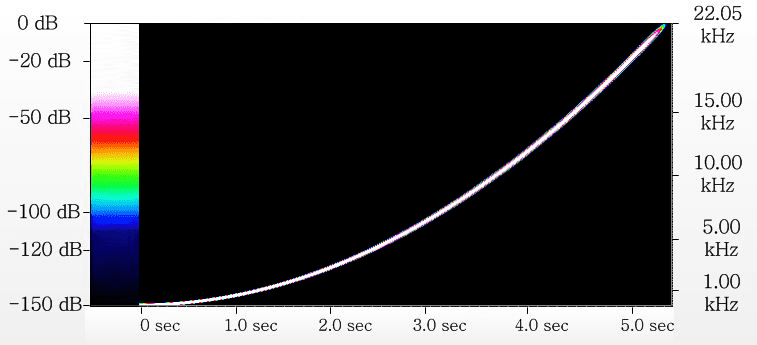
Mid-Fi re-sampling of sweep sine: low aliase level and sweep sine at output
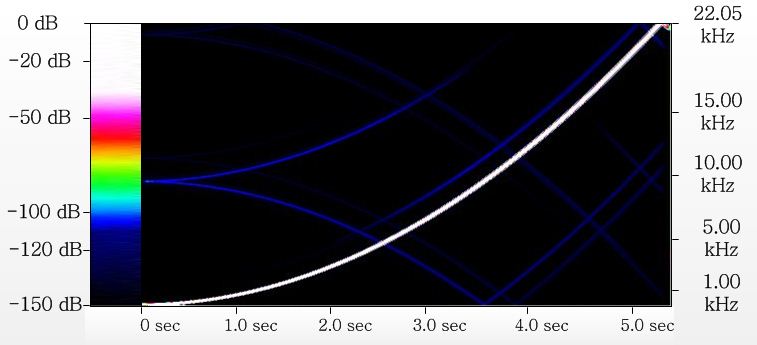
Lo-Fi re-sampling of sweep sine: high aliase level and sweep sine at output
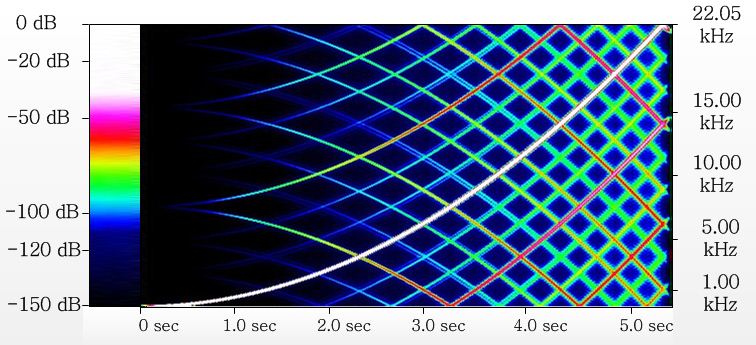
Sample rate converter comparison is performed by alias levels. The best sample rate converter should provide minimum aliases (invisible or almost invisible).
Different converters may not have audible difference. In this case you need check other features that are important for you.
Back to top
Technical support issues
Audio converter is not simple program, as look at first sight. Therefore, errors/bugs may be there.
Each modification of program may cause new bugs.
Programmers says that old bug fixing may generate new bugs.
So bug fixing is infinite process during lifetime of the project.
Also with time appear new demands to audio converters (formats, functionality or other).
No any demands may be released or released in nearest time. But software project, that aimed to the future, collect user's requests for future releases of developed program. Check frequency of releases.
Also pay attention to time of response of tech support of program vendor.
Back to top
Conclusions
The best audio converter software on Mac OS or Windows may be choosen by minimum distortions level first. At first sight right choice between number of alternatives is tough thing.
Fortunately, you can try many free converters and free demo versions of some commercial programs.
Quality may compared by ears or via spectrum analyzing tools (converted file noise/aliases level).
Also to compare sound quality of different conversion tools you can check links below.
You can compare the quality of conversion by ears when playback converted stuff at your player.
A program may have some issues. Pay attention to quality of technical support.
Back to topFrequently Asked Questions
Which sample rate is the best?
Read common advice how to choose the best sample rate...
What is the best sample rate for mixing?
You record your DAW project at some sampling rate. The best decission is use the sampling rate for mixing.
Recording sampling rate may be taken as maximum sampling rate of your audio interface.
If your computer has issues with real-time work with such sampling rate, it's recommended increase sound-card driver's latency or reduce sampling rate.
Is 16-bit or 24-bit audio better?
From theoretical point of view, 24-bit give more abilities to solve distortion issues for quiet music fragments.
Practically, there are several factors does matter.
Reade more...
Should I record 48kHz or 96kHz?
96-kHz sampling rate is preferable in common case by technical reasons.
Which is better 44.1 kHz or 48kHz?
There is no single question. It's defined by your equipment.
Read more...
Is 192kHz better than 48kHz?
Depending on using audio system, 192 kHz may give advantages comparing 48 kHz.
Read details...
Can I convert sample rate?
Yes. You can convert sample rate of an audio files. Read how to do it...
Does converting sample rate affect sound quality?
For high-qualitative converter software, sample rate almost doesn't affect to sound quality.
It depends on algorithms, that the software uses.
In instance, AuI ConverteR is based on individually adjusted resampling filter for each combination input and output sampling rates.
It allows the best sound quality and time performance, that AuI's designers can, for each sample rate.
Also, for DAC, sampling rate may be matter for sound quality. Read more...
Back to top
Read more
Sound quality
Tutorials
- How to Convert CDA to mp3 on Windows 10, 8, 7 >
- How to Convert ISO to DSF under Mac and Windows >
- How to Convert ISO to FLAC under Mac and Windows >
Comparison of audio converters
Back to top
